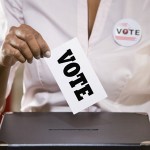 Making voting mandatory in the United States and other similar democracies, along with strict penalties for not participating, might help lessen political divisions and defend democratic institutions from anti-democratic threats, says a paper from the University at Buffalo.
Making voting mandatory in the United States and other similar democracies, along with strict penalties for not participating, might help lessen political divisions and defend democratic institutions from anti-democratic threats, says a paper from the University at Buffalo.
The study uses existing political models in a new way to show how compulsory voting could bring the policy proposals of two major parties closer together. This approach could lead to a more united political environment and strengthen the foundations of democracy.
“One reason for political polarization is that candidates have to cater to their parties’ extremists, who threaten to not turn out unless their demands are met. Compulsory voting could push party platforms toward the center by reducing extremists’ ability to make these kinds of threats. This would directly decrease polarization,” the researchers explain.
Increasing turnout
Voting, traditionally seen as a voluntary act in democracies dating back to ancient Athens, is undergoing a shift. Compulsory voting systems have been introduced, tested, or proposed in numerous democracies.
Presently, 27 countries, including Australia, Belgium, and Peru, enforce compulsory voting, while 12 others have experimented with such a system. Attempts to introduce compulsory voting bills in Canada, the United Kingdom, and France faced setbacks. In the United States, former President Barack Obama supported a form of compulsory voting to boost turnout, particularly among the youth and marginalized communities. A bill is currently being considered in Washington to make voting compulsory in the state.
Compulsory voting involves policies that mandate participation in various elections, allowing voters to abstain by refusing to cast a valid ballot. Enforcement varies, with some systems imposing fines, typically around $20 U.S., for abstaining. Studies indicate that compulsory voting, whether enforced or not, can lead to increased turnout, ranging from 7 to 10 percentage points without enforcement to 14.5 to 18.5 percentage points with enforcement.
Changing the game
“The main idea is not that compulsory voting brings turnout to 100%. But adding 10 to 20% turnout to an election—especially midterm elections in the U.S. that have particularly low turnout—completely changes the political game. Even 5% to 10% would make a significant difference,” the authors explain.
The study conducts theoretical simulations based on three turnout levels (40%, 50%, and 60%), encompassing the range observed in U.S. congressional and presidential elections in the last two decades. Assuming a turnout boost of 16.5 percentage points (midpoint of empirical estimates), even in the least favorable circumstances, there is a notable 22% decrease in polarization.
“We’ve experimented with ranked choice voting, where voters rank candidates according to preference, and other experiments at the municipal level,” the authors conclude. “Our paper suggests compulsory voting would be worth trying, so long as governments can do it legally.”